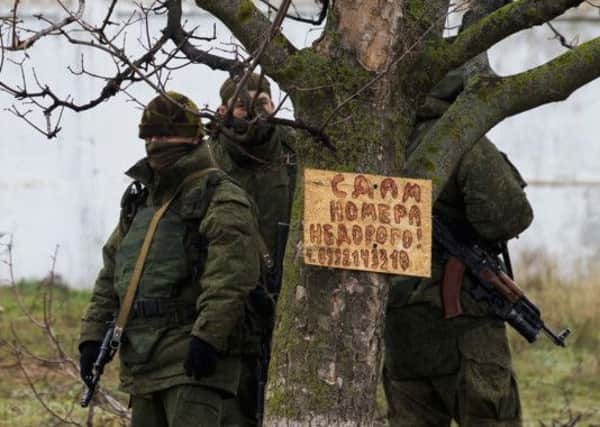Ukraine: Russia sends more troops to Crimea


Moscow’s foreign minister, Sergey Lavrov, ruled out any dialogue with Ukraine’s new authorities, whom he dismissed as the puppets of right wing extremists.
The Russians have denied their armed forces are active in Crimea, instead claiming that masked troops bearing no military badges or insignia are local militia. But one military convoy of army-green vehicles bore Russian licence plates and numbers indicating that they were from the Moscow region. Some towed mobile kitchens and what appeared to be mobile medical equipment.
Advertisement
Hide AdAdvertisement
Hide AdVladislav Seleznyov, a Crimean-based spokesman for the Ukrainian armed forces, told reporters that some witnesses saw amphibious military ships unloading around 200 military vehicles in eastern Crimea on Friday night after apparently having crossed the Straits of Kerch, which separates Crimea from Russian territory.
“Neither the equipment, nor the paratroopers have insignia that identify them as Russian, but we have no doubt as to their allegiance,” Seleznyov said.
Ukraine says the number of Russian troops in Crimea has increased from 11,000 to around 30,000 in recent days.
The amphibious operation appeared to be one of the largest movements of Russian military forces since they appeared in Crimea a week ago. The regional parliament in Crimea has set a 16 March date for a referendum on leaving Ukraine to join Russia, and senior politicians in Moscow said they would support the move, ignoring sanctions threats and warnings from US president Barack Obama that the vote would violate international law.
The strategic peninsula in southern Ukraine has become the flashpoint in the battle for Ukraine, where three months of protests sent president Viktor Yanukovych fleeing to Russia. A majority of people in Crimea identify with Russia, and Moscow’s Black Sea Fleet is based in Sevastopol, as is Ukraine’s.
Lavrov said Moscow sees no sense in having a dialogue with Ukraine’s new authorities because, in his view, they kowtow to ultra-nationalists.
“The so-called interim government isn’t independent, it depends, to our great regret, on radical nationalists who have seized power with arms,” he said at a news conference.
He said that nationalist groups use “intimidation and terror” to control Ukraine.
Advertisement
Hide AdAdvertisement
Hide AdDespite that tough talk, the Russian foreign ministry said Grigory Karasin met yesterday with Ukrainian Ambassador Volodymyr Yelchenko, the first such diplomatic contact since the crisis began.
In a terse statement, the ministry said only that it discussed issues related to Russian-Ukrainian ties in a “sincere atmosphere.”
An international military mission composed of officers from the US and 28 other nations tried again yesterday to enter Crimea, but it was turned back around the town of Armiansk by armed men.
A reporter travelling with the 54 observers from the Organisation for Security and Co-operation in Europe said that after the group had stopped, the armed men fired bursts of automatic weapons fire to halt other unidentified vehicles. No injuries were reported.
On Friday evening, pro-Russia soldiers tried to take over another Ukrainian base in Sevastopol, resulting in a tense standoff that lasted for several hours. Lieutenant Colonel Vitaly Onishchenko, deputy commander of the base, said three dozen men wearing unmarked camouflage uniforms arrived late Friday. While one group climbed over a wall on one side of the base, another crashed a heavy military truck through the gates.
He said yesterday that they turned off power, cut telephone lines and demanded that about 100 Ukrainian troops, who barricaded themselves into one of the base buildings, surrender their weapons and swear allegiance to Russia. The invaders left around midnight.
Virus code points to Moscow involvement
A CYBER weapon known as Ouroboros has infected dozens of Ukrainian networks including government computer systems in one of the most sophisticated attacks in recent years.
Experts have said the virus, named after the serpent of Greek mythology, is as sophisticated as Stuxnet, which disrupted Iran’s uranium enrichment programme in 2010.
Advertisement
Hide AdAdvertisement
Hide AdOuroboros gives its operators unlimited access to networks for surveillance purposes. However, it also acts as a highly advanced “digital beachhead”. This could destroy computer networks and have wide-ranging repercussions for ordinary citizens, experts believe.
It has been deployed since early last year, but only came to light following the overthrow of Viktor Yanukovych’s government. In the latest attack, the Ukrainian news agency Ukrinform was targeted.
Cyber warfare experts have warned that digital weapons could shut off water supplies, cripple banks or even blow up industrial sites that depend on computer-controlled safety programmes.
The origins of Ouroboros, also known as Snake, remain unclear. But its programmers appear to have developed it in a GMT+4 timezone – which includes Moscow. Parts of the code also contain fragments of Russian text, pointing to possible Moscow involvement.
Cyber-attacks were utilised heavily during Russia’s 2008 conflict with Georgia.
BAE Systems’ cyber security unit has said that Ouroboros has been in development for nearly a decade and is too sophisticated to have been programmed by an individual or a non-state organisation.
“Ukraine is top of the list [of infections] and increasing,” Dave Garfield, managing director for cyber security at BAE Systems told the Financial Times, adding that the instances were almost certainly “the tip of the iceberg”.
“Whoever made it really is a very professional outfit,” Garfield said. “It has a very high level of sophistication.”
Advertisement
Hide AdAdvertisement
Hide AdNigel Inkster, former director of operations and intelligence for MI6 and now director at the think tank IISS, said it was highly likely that Russia was behind the attacks.
He told the newspaper: “Until recently the Russians have kept a low profile, but there’s no doubt in my mind that they can do the full scope of cyber attacks, from denial of service to the very, very sophisticated.”
The Ukrainian authorities said last week the country’s telecommunications system had come under cyber attack, with equipment installed in Russian-controlled Crimea used to interfere with the mobile phones of members of parliament.